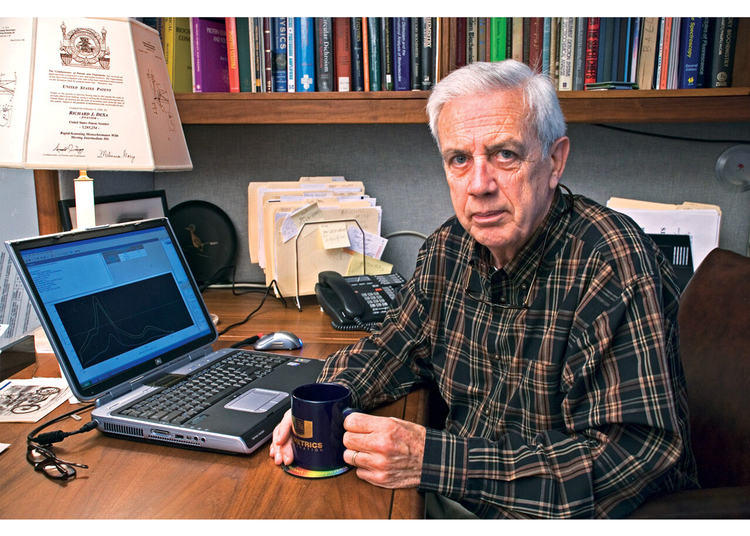Spectrophotometers for Beginners
Circular Dichroism Fundamentals Explained
Table of ContentsMore About Uv/vis/nirSpectrophotometers Fundamentals ExplainedUv/vis/nir Can Be Fun For EveryoneThe Single Strategy To Use For SpectrophotometersThe Greatest Guide To Spectrophotometers

Spectrophotometry is a tool that hinges on the quantitative analysis of particles depending on how much light is soaked up by colored substances.
The Best Strategy To Use For Uv/vis
A spectrophotometer is typically utilized for the measurement of transmittance or reflectance of solutions, transparent or opaque solids, such as sleek glass, or gases. Although numerous biochemicals are colored, as in, they take in noticeable light and therefore can be determined by colorimetric procedures, even colorless biochemicals can frequently be transformed to colored substances appropriate for chromogenic color-forming responses to yield compounds suitable for colorimetric analysis.: 65 Nevertheless, they can likewise be developed to measure the diffusivity on any of the listed light varieties that normally cover around 2002500 nm using various controls and calibrations.
An example of an experiment in which spectrophotometry is used is the decision of the balance constant of a solution. A specific chemical reaction within a solution may occur in a forward and reverse direction, where reactants form items and products break down into reactants. At some point, this chemical response will reach a point of balance called a stability point.
Our Uv/vis Statements
The quantity of light that goes through the service is indicative of the concentration of certain chemicals that do not allow light to pass through. The absorption of light is because of the interaction of light with the electronic and vibrational modes of molecules. Each kind of molecule has a private set of energy levels connected with the makeup of its chemical bonds and nuclei and therefore will soak up light of particular wavelengths, or energies, resulting in special spectral homes.
The usage of spectrophotometers spans various scientific fields, such as physics, products science, chemistry, biochemistry. spectrophotometers, chemical engineering, and molecular biology. They are commonly used in many industries including semiconductors, laser and optical production, printing and forensic examination, along with in labs for the research study of chemical compounds. Spectrophotometry is often utilized in measurements of enzyme activities, determinations of protein concentrations, decisions of enzymatic kinetic constants, and measurements of ligand binding reactions.: 65 Ultimately, a spectrophotometer has the ability to determine, depending on the control or calibration, what compounds exist in a target and exactly how much through computations of observed wavelengths.
This would come as a service to the previously internet created spectrophotometers which were unable to take in the ultraviolet correctly.
Some Known Questions About Spectrophotometers.
It would be found that this did not offer acceptable results, for that reason in Model B, there was a shift from a glass to a quartz prism which allowed for better absorbance results - circular dichroism (https://www.livebinders.com/b/3570027?tabid=514355ed-03f4-acee-f8e7-d79f6b7bffab). From there, Design C was born with a change to the wavelength resolution which wound up having 3 systems of it produced
It was produced from 1941 to 1976 where the rate for it in 1941 was US$723 (far-UV accessories were an alternative at extra cost). In the words of Nobel chemistry laureate Bruce Merrifield, it was "most likely the most essential instrument ever developed towards the advancement of bioscience." Once it became stopped in 1976, Hewlett-Packard developed the very first commercially offered diode-array spectrophotometer in 1979 referred to as the HP 8450A. It irradiates the sample with polychromatic light which the sample takes in depending upon its residential or commercial properties. Then it is sent back by grating the photodiode variety which finds the wavelength region of the spectrum. Ever since, the development and application of spectrophotometry devices has increased profoundly and has actually turned into one of the most ingenious instruments of our time.

The Facts About Spectrophotometers Revealed
Historically, spectrophotometers utilize a monochromator consisting of a diffraction grating to produce the analytical spectrum. The grating can either be movable or repaired. If a single detector, such as a photomultiplier tube or photodiode is used, the grating can be scanned step-by-step (scanning spectrophotometer) so that the detector can measure the light strength at each wavelength (which will correspond to each "step").
In such systems, the grating is fixed and the intensity of each wavelength of light is determined by a different detector in the variety. In addition, most modern-day mid-infrared spectrophotometers use a Fourier change technique to get the spectral information - https://www.abnewswire.com/companyname/olisclarity.com_129679.html#detail-tab. This strategy is called Fourier change infrared spectroscopy. When making transmission measurements, the spectrophotometer quantitatively compares the portion of light that travels through a recommendation solution and a test service, then electronically compares the strengths of the two signals and calculates the percentage of transmission of the sample compared to the referral standard.
